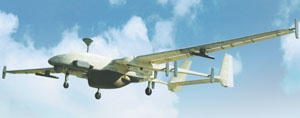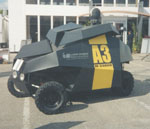Israel Deploys Robot Guardians
Years of experience with unmanned systems have refined border, maritime surveillance missions. 
Israel Aircraft Industries International (IAI) Incorporated has been involved in developing unmanned systems for the Israeli military since the 1970s. The firm produces a family of unmanned aerial vehicles ranging from a hand-launched tactical model such as the Bird Eye 400 to long-endurance platforms like the Heron (shown here).
A close
One of the key firms involved in unmanned systems research and design is Israel Aircraft Industries International (IAI) Incorporated,
The company official, speaking on condition of anonymity, believes that the Israeli Ministry of Defense was more agile in its thinking about how to deploy unmanned systems than were larger nations’ militaries.
And once the Israeli military accepted UAVs, it wanted more of them. “The more the military uses UAVs, the more applications it finds for them. Today, there is hardly a scenario that’s being played out without UAVs,” he says.
The company developed its first UAV for the Israeli Air Force in the mid-1970s. At the time, robot aircraft were viewed as little more than model aircraft—not something in which a major aerospace firm would become involved. But IAI’s engineers were determined to design the UAV as a robust small aircraft. This ruggedness is necessary because tactical UAVs must withstand the stress of being picked up by the wings and moved by soldiers.
Much was learned during the development of the Scout, IAI’s first UAV. At that time, many of the components of UAVs did not exist and had to be designed from scratch. “There weren’t any engines, communications equipment or servo actuators for the control surfaces. Nothing. So it became fairly expensive to design,” he says.
These early UAVs also lacked adequate sensor systems. Israeli engineers had to develop stabilized electro-optic systems for use on small platforms.
Controlling UAVs was another design issue. The official explains that it is difficult to fly an aircraft remotely without automated flight control systems. IAI decided to simplify UAV flight to allow non-pilots to fly missions. “There are no pilots in
Increasing automation will reduce the number of operators required for many UAV systems. Standard UAV control facilities usually have two or three positions for an aircraft controller and mission specialists. The goal is to cut the number of personnel to one operator. Smaller crews lower operating costs.
One ongoing trend in unmanned systems is increased reliability. The Israeli air force initially viewed its UAVs as expendable. However, they were significantly more expensive than originally estimated and operational losses led to investigations. The IAI official explains that the outcome of these inquiries put a focus on system reliability.
Another lesson learned was to design electrical systems so that no single system failure would cause an aircraft to be lost. But as expensive as an individual UAV may be, sensor payloads such as synthetic aperture radar systems may cost much more than the aircraft. The official notes that larger UAVs are now almost as reliable as general aviation aircraft and feature double redundancies in critical systems. “You can lose the mission but not the aircraft. You should be able to bring the aircraft back because it’s too expensive [to lose],” he says.
As UAV capabilities grew, so did their operational niches. Besides reconnaissance and intelligence gathering, unmanned aircraft are now available in a variety of sizes, from large, long-duration platforms to small, hand-launched tactical models. IAI’s Heron and Eagle UAVs can remain airborne up to 52 hours, which is significant for a medium-size platform.
In the last decade,
 |
| IAI also is developing unmanned ground vehicles (UGVs) such as the Guardium. This UGV is designed for perimeter security on bases and other secure facilities. It can navigate these areas autonomously and interface with sensor systems to provide operators with real-time video imagery. Designed to augment security personnel, a Guardium unit can be overridden by human operators in an emergency. |
The official observes that nations with long coastlines such as the
Operating in national airspace is another challenge confronting UAV operation. Because
A major point of contention is the FAA’s “see and avoid” criteria, which apply to small general aviation aircraft. But the official notes that when aircraft are equipped with the right sensors and a flight plan is filed, they meet these requirements more effectively than many private aircraft. “Think about a general aviation pilot in a small aircraft flying at night in the rain. He doesn’t see anything; he’s flying with his instruments. So what’s the difference between this general aviation pilot and a UAV where the operator is on the ground?” he posits.
The official notes that the UAV operator has more information coming in via sensors and other systems than does a small aircraft pilot. In radar-equipped UAVs, this situational awareness is even more enhanced. For example, the search radar Heron maritime UAVs use was originally developed for fighter jets and can still be used to detect aircraft. This situational awareness capability allows maritime UAV operators to know exactly the location of other air traffic. “You look for ships, but once every 10 sweeps, the same radar does an air-to-air sweep to see if there is someone around you,” he says.
Situational awareness also is important for combat operations. As systems become more automated, acquiring positive target identification is crucial before a weapon is deployed. This recognition capability is essential for maritime UAVs because hostile targets may be intermingled with commercial shipping traffic. “If you launch a harpoon [missile] 50 to 70 miles, by the time it gets to the target, the whole situation may have changed. The ships may have gone in different directions, and you want to make sure it still knows which one is the target. So you need to be able to close this loop, either with a UAV that serves as a relay or with some other means. You still need a man in the loop, although you may not in 10 or 20 years,” he speculates.
Technologies such as automatic target recognition will allow future UAVs to identify moving targets such as ships because it will have their radar, visual and infrared signatures stored in memory. The official predicts that future autonomous systems will have a high probability of correctly identifying targets without human intervention.
While UAVs have made an operational space for themselves, unmanned ground vehicles (UGVs) are still in their early developmental stages because the ground environment is very complex for automated navigation. It is easier for an aircraft to move in a three-dimensional space with few obstacles compared to reacting to events on the ground. “The main issue is situational awareness. How does the UGV know where it is and what’s around it? That is the most complex thing to do,” he says.
Technologies such as machine vision to identify objects such as stones and potholes continue to be a developmental challenge. The official notes that the human mind processes a tremendous amount of data to identify its surroundings, but programming a machine to do this automatically is still many years away.
Because of these navigational challenges, many UGVs are operated remotely. IAI’s Guardium UGV has some automatic functions, allowing it to operate with limited independence in a known environment such as the perimeter of a facility. “You know what’s in there, you can map it completely. So if you want to send it from one point to another, you can,” he says.
This autonomous capability, not possible a decade ago, can be achieved with global positioning system data and algorithms. But UGVs such as Guardium still cannot operate independently on public roads.
The Israeli navy and other navies also are devoting funds to underwater unmanned vehicles (UUVs) because they are more cost-effective than submarines for some missions. Missions such as mine detection and neutralization are the primary focuses of UUV research and development. He speculates that future UUVs may undertake offensive combat operations and that these platforms may be a cross between an unmanned submarine and a torpedo that may deploy its own UUVs or weapons. But he adds that complex issues such as undersea communications must be resolved before autonomous UUVs are ready for deployment.
Web Resources
Israel Aircraft Industries International Incorporated: www.iai.co.il
Israeli Ministry of Defense: www.mod.gov.il



